Plato and the Short Chronology — Some Observations
The Short Chronology—for which see Ginenthal (2003, 2009, 2010, 2013)—involves such a radical realignment of ancient history that the question must arise, If our conventional chronology of ancient history is so inaccurate, why is it not repeatedly falsified by the Classical authors? After all, men like Herodotus and Thucydides lived much closer to the events in question than we do, giving them a unique perspective on the past. In fact, the writings of the Classical authors do indeed provide us with a ready-made testing ground for both conventional and unconventional chronologies, and Plato’s final dialogue, the Laws, is a case in point.
The Laws was written around 350 BCE, when Plato was an old man. The subject matter of the dialogue is not relevant to this discussion, so we will not be going into it here. What is important is a remark made by one of Plato’s characters, known only as the Athenian, in Book III:
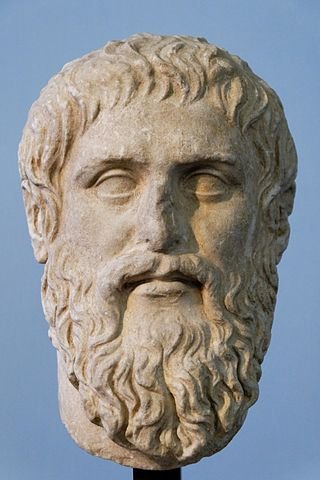
Well then, it’s pretty obvious that they intended the arrangements they made to protect adequately not only the Peloponnese but the Greeks in general against any possible attack by non-Greeks—as for example occurred when those who then lived in the territory of Ilium trusted to the power of the Assyrian empire, which Ninos had founded, and provoked the war against Troy by their arrogance. You see, a good deal of the splendor of the Assyrian empire still remained, and the dread of its united organization was the counterpart in that age of our fear of the Great King of Persia today. The Assyrians had a tremendous grudge against the Greeks: Troy, which was part of the Assyrian empire, had been captured for a second time. (Plato, Laws 685b-d)
This is a remarkable passage, and its significance for the Short Chronology can hardly be exaggerated. The Athenian says several things in this brief extract that no conventional historian today can possibly accept. But he says these things off the cuff, as it were, merely to illustrate another point he is trying to make (and which need not concern us). He clearly assumes that the men he is talking to are already conversant with the Trojan War, and are quite familiar with the relevance of the Assyrian Empire to that conflict. If he first had to explain all of this to them, or try to convince them of it, it would defeat the purpose of bringing it up as an illustration.
So just what does he say?
The Trojans behaved arrogantly towards the Greeks because they believed that with the might of the Assyrian Empire at their backs they were safe from any possible retaliation.
The Assyrian Empire had been founded by Ninos.
A good deal of the splendor of the Assyrian empire still remained at the time of the Trojan War.
The Greeks at the time of the Trojan War feared the Assyrian Empire in the same way that the Greeks of Plato’s time feared the Persian Empire.
At the time of the Trojan War, Troy was part of the Assyrian Empire.
In the light of conventional history and chronology these are extraordinary statements for a man of Plato’s intelligence and erudition to make. Just how extraordinary they are will become clear once we have reminded ourselves of the course of Assyrian history as it is currently set out in the textbooks.
Assyria and Troy According to the Conventional Chronology
The following figure summarizes the conventional chronology of Assyrian history.
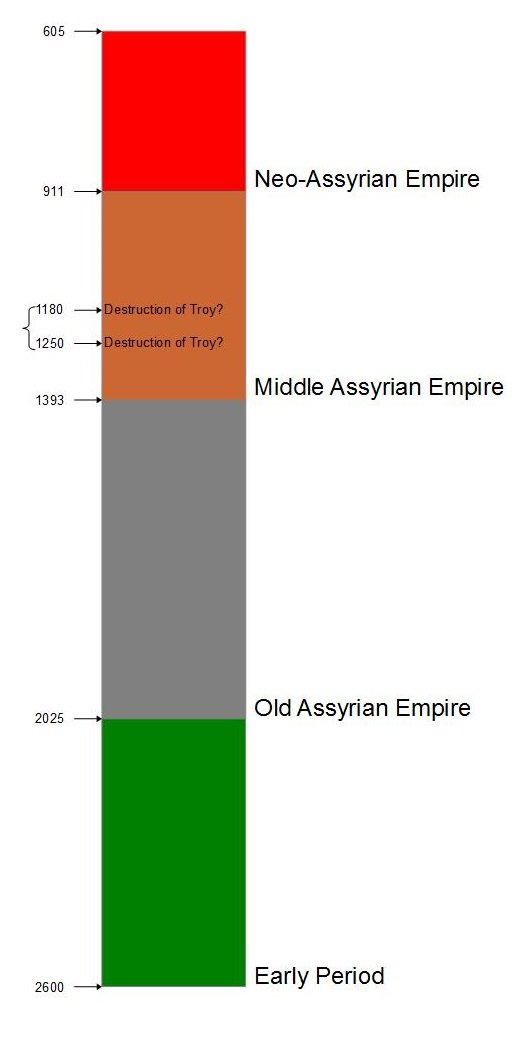
There is still much scholarly debate concerning the historicity and chronology of the Trojan War, but the two leading archaeologists who excavated the site of Troy in the 20th century—Carl Blegen and Manfred Korfmann—believed that there was a historical basis to the story. Blegen placed the destruction of Homer’s Troy around 1250 BCE, while Korfmann placed it around 1180 BCE. It is probably safe to assume that most conventional historians who accept the historicity of the Trojan War would place the fall of Troy somewhere between these dates.
The first thing about this timeline that strikes us is the fact that there were three Assyrian Empires. Plato’s Athenian speaks of the Assyrian Empire as though there was only ever one. Perhaps when he says, “the Assyrian empire, which Ninos had founded,” he means “the Assyrian empire that Ninos founded (and not one of the other Assyrian empires that have also existed)”; but this seems unlikely.
In fact none of the Classical historians ever mentions more than one Assyrian empire. Herodotus tells us that the Assyrians were “masters of upper Asia over a period of 520 years” (Herodotus 1.96), while Diodorus Siculus quotes Ctesias of Cnidus as saying in his Second Book that “the rest of the kings also followed [Ninus’s] example, son succeeding father upon the throne, and reigned for thirty generations down to Sardanapalus; for it was under this ruler that the Empire of the Assyrians fell to the Medes, after it had lasted more than thirteen hundred years.” Neither of these accounts can be squared with the Conventional or the Short Chronology, but they are more problematic for the former. In the Short Chronology the Assyrian Empire endures for less that 300 years, but the Assyrian state is independent for a total of 500-600 years, so Herodotus’s account makes some sense in this paradigm. Ctesias’s 1300 years is too long for the Short Chronology and too short for the Conventional; but 30 generations of rulers can hardly span one millennium, let alone 1300 years. The first three centuries of the Roman Empire had over forty emperors. In Japan, the last thirty emperors have reigned for only 700 years. So even Ctesias’s numbers can be accommodated to the Short Chronology.
The second thing which strikes us is that the period of the Trojan War falls within the Middle Assyrian Empire. This was not the high point of Assyrian expansion, which occurred during the much more recent Neo-Assyrian Empire (911–605 BCE). In fact, during the Middle-Assyrian period the northwestern boundary of the empire rarely extended beyond the Euphrates:
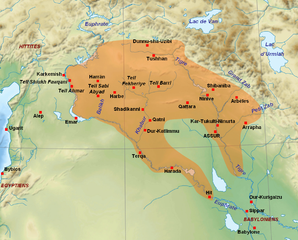
The area between the Tigris and the Euphrates is also known as the Jezira. The Middle-Assyrian history mostly evolved in this area. (Kertai 2008-2009:28)
The emperors who reigned during the Trojan period—Shalmaneser I, Tukulti-Ninurta I, Assur-nadin-apli, Assur-nirari III, Enlil-kudurri-usur and Ninurta-apil-Ekur—never controlled any territory west of the Euphrates (Kertai 2008-2009:31-41). This is roughly 1500 km from Troy. It is inconceivable that the Middle-Assyrians can have had the slightest influence on events taking place in the Troad.
Assyria and Troy According to the Short Chronology
Now let us look at the timeline of Assyrian history according to the Short Chronology. The Roman annalist Aemilius Sura (2nd century BCE?) is quoted by the 1st-century historian Marcus Velleius Paterculus in the following extract:
The Assyrians were the first of all nations to rule the world, then the Medes, after them the Persians, and then the Macedonians. (Velleius Paterculus 1.6.6)
This is the pattern adopted by adherents of the Short Chronology. The Assyrian Empire (also known as the Akkadian Empire and, in Egypt, the kingdom of the Hyksos) fell to the Medes, the Median Empire (also known as Mitanni) was conquered by the Persians, and the Persian Empire (which incorporates most if not all of the so-called Neo-Assyrian Empire) was conquered by the Macedonian Alexander the Great.
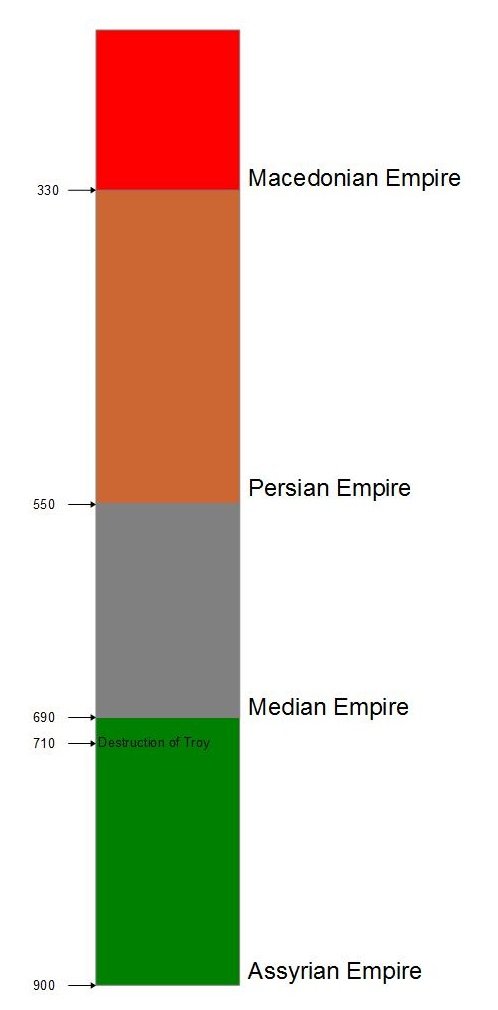
The Short Chronology is a work-in-progress: although its adherents are in general agreement as far as the main points are concerned, there is still no consensus when it comes to the details. For example, Charles Ginenthal (2010:542) tentatively places the expulsion of the Assyrians (or Hyksos) from Egypt in 763 BCE, whereas Emmet J Sweeney places this event “around 700 BC” or “around 710 BC”. Similarly, there is no consensus concerning the precise date of the fall of Troy. Immanuel Velikovsky, the father of the Short Chronology, places it in “the second half of the eighth century, and not later than –687”, while Sweeney (ibidem) pins it down more precisely: “Evidence from Greece therefore shows that the Trojan Campaign must have occurred around 710 BC.”
Nevertheless, all the principal proponents of the Short Chronology subscribe to the following claims:
There was only one Assyrian Empire
It probably existed sometime between 900 and 600 BCE
In the conventional chronology, the Akkadian Empire (2334-2154 BCE), the Old Assyrian Empire (2025-1378 BCE) and the Hyksos Kingdom in Egypt (1650-1550 BCE) represent a triplication of the one true Assyrian Empire
The late Mycenaean Age, in which the Trojan War occurred, corresponds to the late 8th century BCE
When the Trojan War took place—around 710 BCE—the Assyrian Empire was still in existence, but the Assyrians (ie the Hyksos) had withdrawn from Egypt, or were soon to do so. The Empire, in other words, was in decline, but “a good deal of the splendor of the Assyrian empire still remained,” as Plato’s Athenian said.
The claim that Troy was part of the Assyrian Empire, or even within Assyria’s sphere of influence, may seem somewhat far-fetched, but accounts of the Akkadian emperors associate some of them with regions that were quite remote from Assyria proper, notwithstanding the current uncertainty as to their precise locations: Magan (Egypt?), Meluhha (Nubia?), Dilmun (the Indus Valley?) and Kuppara (Cyprus? Crete?). One of the Akkadian emperors, Naram-Sin, is even said to have campaigned in Anatolia. Because these rulers are believed to have reigned in the third millennium BCE, conventional historians cannot bring themselves to credit such accounts. 2200 BCE is considered much too early for so expansive an empire. But when these events are relocated to the ninth or eighth century BCE, they no longer sound far-fetched.
The Laws is possibly the earliest surviving work to associate the fall of Troy with the Assyrian Empire. Herodotus promised to tell the history of Assyria (Herodotus 1.184), but he never did. Several historians who came after Plato, however, confirmed the association. For example, Diodorus Siculus wrote at some length on the history of Assyria and the role it played in the Trojan War, though his source for this material was Ctesias of Cnidus, a contemporary of Plato’s:
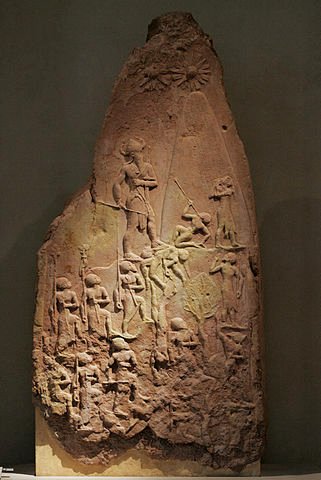
In the earliest age, then, the kings of Asia were native-born, and in connection with them no memory is preserved of either a notable deed or a personal name. The first to be handed down by tradition to history and memory for us as one who achieved great deeds is Ninus, king of the Assyrians, and of him we shall now endeavour to give a detailed account. (Diodorus Siculus 2.1)
Of the lands which lie on the sea and of the others which border on these, Ninus subdued Egypt and Phoenicia, then Coele-Syria, Cilicia, Pamphylia, and Lycia, and also Caria, Phrygia, and Lydia; moreover, he brought under his sway the Troad, Phrygia on the Hellespont, Propontis, Bithynia, Cappadocia, and all the barbarian nations who inhabit the shores of the Pontus as far as the Tanaïs [River Don]; he also made himself lord of the lands of the Cadusii, Tapyri, Hyrcanii, Drangi, of the Derbici, Carmanii, Choromnaei, and of the Borcanii, and Parthyaei; and he invaded both Persis and Susiana and Caspiana, as it is called, which is entered by exceedingly narrow passes, known for that reason as the Caspian Gates. Many other lesser nations he also brought under his rule, about whom it would be a long task to speak. But since Bactriana was difficult to invade and contained multitudes of warlike men, after much toil and labour in vain he deferred to a later time the war against the Bactriani, and leading his forces back into Assyria selected a place excellently situated for the founding of a great city. (Diodorus Siculus 2.2)
The identity of Ninus is still a mystery. Gunnar Heinsohn has suggested that this name refers to the Akkadian ruler Naram-Sin, whose deeds became the stuff of legend for later generations, making it all but impossible to separate fact from fiction (Westenholz 1997:173–369). His grandfather, Sargon of Akkad, was also celebrated by later generations (Westenholz 1997:33-172). In one epic, the King of Battle, Sargon leads an expedition into Anatolia, crosses the Mediterranean Sea and visits Kuppara (Cyprus or Crete). Another text, the Chronicle of Early Kings, asserts that he “conquered the western land to its farthest point. He brought it under one authority. He set up his statues there and ferried the west’s booty across on barges.”
These accounts may not be taken seriously by modern historians, but it cannot be denied that the Classical world believed that at the time of the Trojan War Troy lay within the sphere of influence of the Assyrian Empire, if it was not actually part of that empire:
There is no special need of giving all the names of the kings [of Assyria] and the number of years which each of them reigned because nothing was done by them which merits mentioning. For the only event which has been recorded is the despatch by the Assyrians to the Trojans of an allied force, which was under the command of Memnon the son of Tithonus. For when Teutamus, they say, was ruler of Asia, being the twentieth in succession from Ninyas the son of Semiramis, the Greeks made an expedition against Troy with Agamemnon, at a time when the Assyrians had controlled Asia for more than a thousand years. And Priam, who was king of the Troad and a vassal of the king of the Assyrians, being hard pressed by the war, sent an embassy to the king requesting aid; and Teutamus despatched ten thousand Ethiopians and a like number of the men of Susiana along with two hundred chariots, having appointed as general Memnon the son of Tithonus. Now Tithonus, who was at that time general of Persis, was the most highly esteemed of the governors at the king’s court, and Memnon, who was in the bloom of manhood, was distinguished both for his bravery and for his nobility of spirit. He also built the palace in the upper city of Susa which stood until the time of the Persian Empire and was called after him Memnonian; moreover, he constructed through the country a public highway which bears the name Memnonian to this time. But the Ethiopians who border upon Egypt dispute this, maintaining that this man was a native of their country, and they point out an ancient palace which to this day, they say, bears the name Memnonian. At any rate, the account runs that Memnon went to the aid of the Trojans with twenty thousand foot-soldiers and two hundred chariots; and he was admired for his bravery and slew many Greeks in the fighting, but was finally ambushed by the Thessalians and slain; whereupon the Ethiopians recovered his body, burned the corpse, and took the bones back to Tithonus. Such is the account concerning Memnon that is given in the royal records, according to what the barbarians say. (Diodorus Siculus 2.22)
Doubting Plato
The only recourse left to supporters of the conventional chronology is to accuse Plato of fabricating history to suit himself. This is the response of Benjamin Jowett, who translated the Laws in the 19th century:

The fictions of the Laws have no longer the verisimilitude which is characteristic of the Phaedrus and the Timaeus, or even of the Statesman. We can hardly suppose that an educated Athenian would have placed the visit of Epimenides to Athens ten years before the Persian war, or have imagined that a war with Messene prevented the Lacedaemonians from coming to the rescue of Hellas. The narrative of the origin of the Dorian institutions, which are said to have been due to a fear of the growing power of the Assyrians, is a plausible invention, which may be compared with the tale of the island of Atlantis and the poem of Solon, but is not accredited by similar arts of deception. The other statement that the Dorians were Achaean exiles assembled by Dorieus, and the assertion that Troy was included in the Assyrian Empire, were traditional (cp. for the latter, Diod. Sicul. ii.2) but have no historical foundation. (Benjamin Jowett 1892:xx)
But there is no more reason to suppose that the Dorian rule of life which was followed at Sparta ever prevailed in Argos and Messene, than to assume that Dorian institutions were framed to protect the Greeks against the power of Assyria; or that the empire of Assyria was in any way affected by the Trojan war ... Such fancies were chiefly based, as far as they had any foundation, on the use of analogy, which played a great part in the dawn of historical and geographical research. Because there was a Persian empire which was the natural enemy of the Greek, there must also have been an Assyrian empire, which had a similar hostility; and not only the fable of the island of Atlantis, but the Trojan war, in Plato’s mind derived some features from the Persian struggle. So Herodotus makes the Nile answer to the Ister, and the valley of the Nile to the Red Sea. In the Republic, Plato is flying in the air regardless of fact and possibility—in the Laws, he is making history by analogy. In the former, he appears to be like some modern philosophers, absolutely devoid of historical sense; in the latter, he is on a level, not with Thucydides, or the critical historians of Greece, but with Herodotus, or even with Ctesias. (Benjamin Jowett 1892:lxxxiv)
It need hardly be pointed out that the Laws is not a novel but a polemical work that sets out an elaborate argument in a difficult field. Plato did not write this dialogue to entertain his readers, but to persuade them. One wonders how he ever hoped to convince anyone of anything if he chose to illustrate his points by simply making stuff up! Clearly the relationship between Greece, Troy and the Assyrian Empire was common knowledge in Plato’s day, or he would not have invoked it by way of illustration in the first place.
The brief remarks quoted above from one of the most influential works by one of the most influential thinkers of all time are further evidence that there is something fundamentally flawed with the conventional chronology of ancient history. The Short Chronology seeks to, and does, correct such flaws.
References
- Charles Ginenthal, Pillars of the Past, Volumes I-IV, Forest Hill, New York (2003, 2009, 2010, 2013)
- Gunnar Heinsohn, Cyaxares: Media’s Great King in Egypt, Assyria & Iran, The Circle of Ancient Iranian Studies (May 2006)
- Benjamin Jowett (translator), The Dialogues of Plato, Volume V, Macmillan & Co, London (1892)
- David Kertai, The History of the Middle-Assyrian Empire, Talanta XL-XLI (2008-2009)
- Plato, The Laws, Trevor J Saunders (translator), in John M Cooper (editor), Plato: Complete Works, Hackett Publishing Company, Inc, Indianapolis (1997)
- Emmet J Sweeney, The Sixth Dynasty of Egypt and the Hyksos, Did_the “Mask of Agamemnon” Really Cover the Face of Atreus’ Son?
- Immanuel Velikovsky, The Dark Age of Greece (unpublished)
- Marcus Velleius Paterculus, Historiarum ad M. Vinicium consulem libri duo (Compendium of Roman History)
- John Goodnick Westenholz, Legends of the Kings of Akkade: The Texts, Eisenbrauns, Winona Lake, Indiana (1997)
Image Credits
- Plato, after Silanion: © Marie-Lan Nguyen, Wikimedia Commons, Creative Commons License
- Conventional Chronology: Public Domain
- Middle Assyrian Empire: Sémhur, Wikimedia Commons, Creative Commons License
- Short Chronology: Public Domain
- Victory Steele of Naram-Sin: Rama, Wikimedia Commons, Creative Commons License
- Benjamin Jowett: E H H Cameron, Public Domain
A monumental post! Thank you for sharing, namaste :)